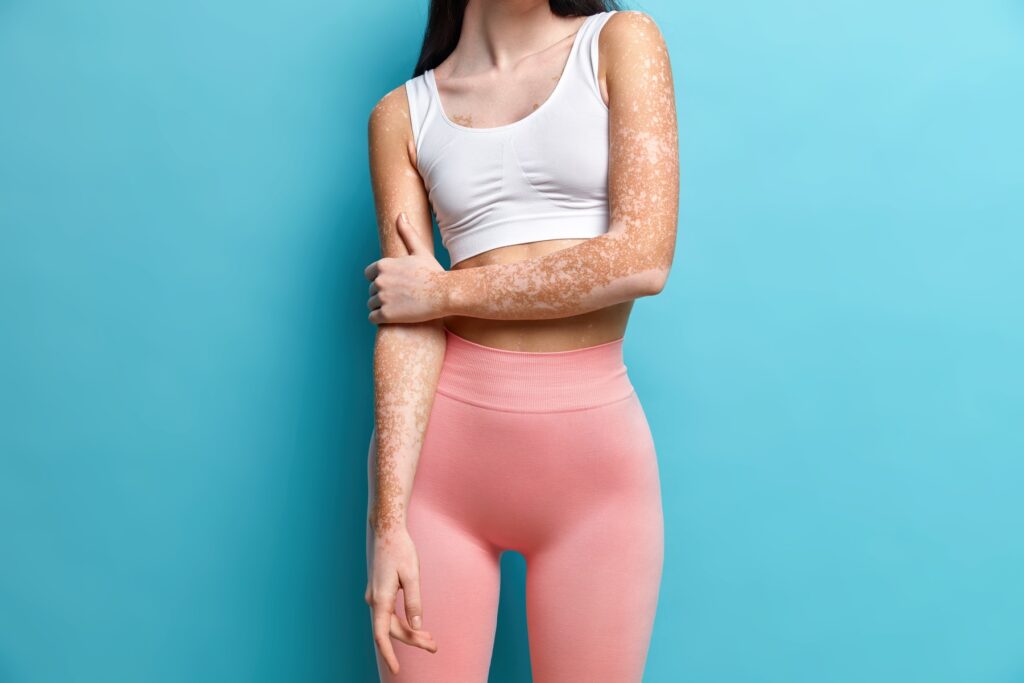- 70855-06939
- drponamrathod025@gmail.com
- Sandeep Vihar Society ,GH 79, Sect 20, Panchkula

Vitiligo
Vitiligo is a chronic skin condition characterized by the loss of melanin, the pigment responsible for skin, hair, and eye color. Vitiligo results in white patches on the skin that can appear anywhere on the body. Although vitiligo affects individuals of all skin types, its visual contrast is more pronounced in those with darker skin tones.
What Causes Vitiligo?
Vitiligo occurs when melanocytes, the cells responsible for producing melanin, are destroyed or cease to function. Several factors are believed to contribute to this process:
- Autoimmune Reaction: In many cases, the immune system mistakenly attacks healthy melanocytes.
- Genetic Predisposition: A family history of vitiligo or other autoimmune conditions increases susceptibility.
- Oxidative Stress: Imbalance in free radicals and antioxidants can damage melanocytes.
- Environmental Triggers: Factors like sunburn, exposure to industrial chemicals, or emotional stress might initiate or worsen vitiligo.
Symptoms and Types of Vitiligo
Symptoms
- Depigmented Patches: White, irregularly shaped patches that grow over time.
- Symmetrical Appearance: Often, patches develop symmetrically on both sides of the body.
- Affecting Hair and Eyes: In some cases, hair growing on affected areas may lose pigment, and changes can occur in the retina.
Types of Vitiligo
- Generalized Vitiligo: The most common form, with patches distributed across various body parts.
- Segmental Vitiligo: Patches appear on one side of the body, often developing earlier in life.
- Focal Vitiligo: Depigmentation is limited to a small area and doesn’t spread widely.
- Acrofacial Vitiligo: Affects the extremities like hands, feet, and face.
- Universal Vitiligo: Rare, involving the loss of pigmentation over most of the body.
Impact of Vitiligo
Vitiligo is not harmful or contagious, but it can have a significant psychological and emotional impact. Visible changes in skin color may affect self-esteem, leading to anxiety or depression. Education and support are essential to help individuals cope with the condition and its effects.
Treatment Options for Vitiligo
While there is no definitive cure for vitiligo, several treatments can improve its appearance and slow its progression:
1. Topical Medications
- Corticosteroids: Help reduce inflammation and may restore pigmentation in early stages.
- Calcineurin Inhibitors: Effective for sensitive areas like the face and neck.
2. Light Therapy
- Narrowband UVB (NB-UVB): A common treatment that stimulates melanocyte activity and slows progression.
- Excimer Laser: Targets small areas of depigmentation with precision.
3. Surgical Treatments
- Skin Grafting: Healthy, pigmented skin is transplanted to depigmented areas.
- Melanocyte Transplantation: Cultured melanocytes are implanted into white patches.
4. Depigmentation Therapy
For widespread vitiligo, depigmentation of unaffected areas may create a uniform skin tone using chemicals like monobenzone.
5. Camouflage Products
Makeup and self-tanning lotions provide temporary solutions to blend patches with surrounding skin.
Lifestyle and Coping Strategies
- Sun Protection: Use broad-spectrum sunscreen to prevent sunburn on depigmented areas, which lack natural protection.
- Healthy Diet: Antioxidant-rich foods may support skin health and overall well-being.
- Emotional Support: Joining support groups or seeking counseling can help manage the psychological impact of vitiligo.
- Clothing Choices: Protective clothing and accessories can shield sensitive skin from excessive sun exposure.
Research and Future Developments
Ongoing research offers hope for more effective vitiligo treatments. Innovations in stem cell therapy, gene editing, and immune-modulating drugs may revolutionize treatment approaches in the future. Additionally, public awareness and advocacy are helping to reduce stigma and promote acceptance of those with vitiligo.
Conclusion
Vitiligo is a complex condition that extends beyond its physical symptoms to affect emotional and social well-being. Understanding its causes, symptoms, and treatment options empowers individuals to make informed decisions about managing their condition. With the right combination of medical care, self-care, and emotional support, individuals with vitiligo can lead confident, fulfilling lives.
Menu
